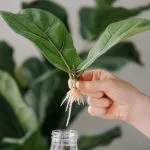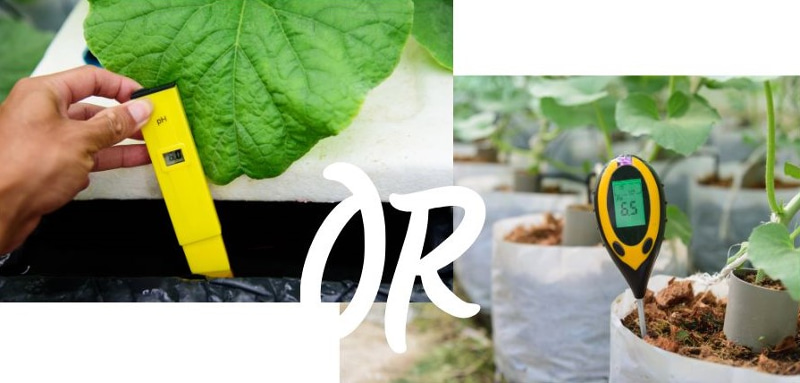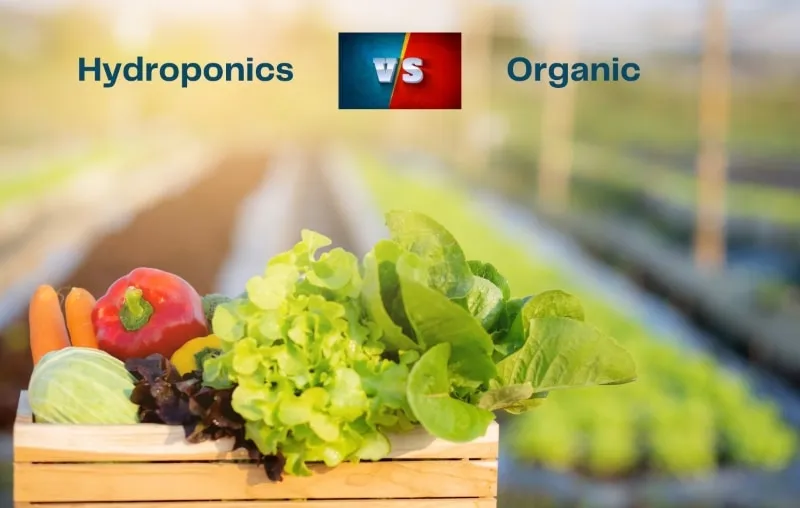Propagating plants through hydroponic systems is an efficient way to grow your favorite plants, and using rooting hormones can significantly increase the success rate of this process. When you use rooting hormones, you’ll find that your plant cuttings develop roots more rapidly, resulting in healthier and stronger plants. In this article, you’ll learn how to use rooting hormone on cuttings for hydroponic plant propagation, helping you achieve better results in your garden.
To begin, it’s essential to take healthy cuttings from the parent plant. Make sure the plant is vigorous and select a growing tip that is between three to eight inches long with a sharp knife or scissors. Cuttings should be 2-6 inches long and contain at least 2-3 leaves. Next, you’ll need to apply the rooting hormone to your plant cuttings. There are several types of rooting hormones available, including liquid and powder forms. You can either dip the base of the cutting into the hormone and shake off any excess or mix the powder rooting hormone with water and apply it to the stems.
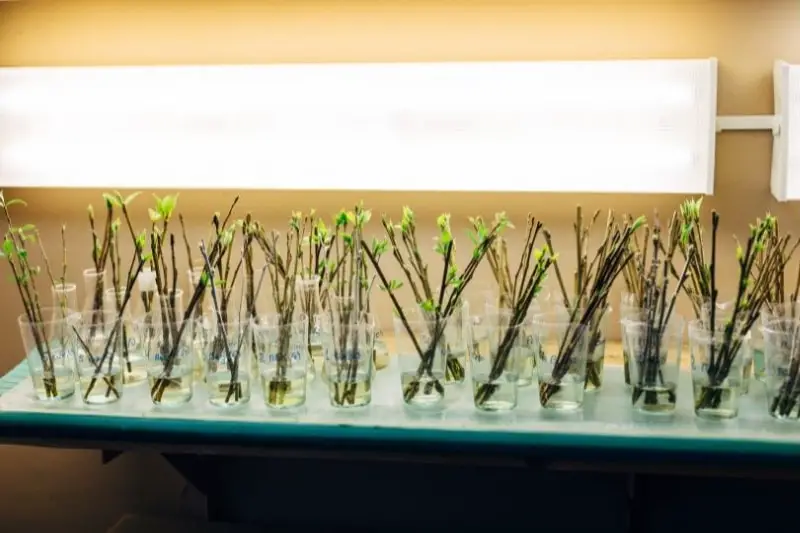
After you have applied the rooting hormone to your plant cuttings, you can place them in your hydroponic system. Ensure that the cutting’s base is inserted in the moistened growing medium or nutrient solution, preferably with a slight angle. Your plants will begin to develop roots and grow, benefiting from the use of rooting hormone in their propagation process.
What is Rooting Hormone and How Does it Work?
Rooting hormone is a substance used to stimulate the growth of new roots on plant cuttings. It contains plant hormones that promote root development and cell division. When applied to a plant cutting, rooting hormone encourages the formation of new roots, which helps the cutting to establish itself as a new plant. The hormone works by triggering the plant’s natural response to injury, which includes the growth of new roots. Using rooting hormone can increase the success rate of plant propagation and help you grow new plants more quickly and easily.
Do You Need Rooting Hormone?
Rooting hormone is not always a necessity, as some plants can propagate just fine with water or soil. However, using rooting hormone can dramatically increase the success rate of propagation, particularly for challenging or less vigorous plants. Plants with woody stems also greatly benefit. When in doubt, consider using rooting hormone to improve your chances of successful cloning and growth.
Types of Rooting Hormones
There are three common types of rooting hormones you may encounter:
- Powder: Easy to use and store, simply dip the base of your cutting into the powder before placing it in your growing medium. Shake off any excess powder before inserting it. Powdered hormones have a long shelf life, don’t need refrigeration, and are typically more affordable.
- Gel: This sticky substance adheres well to the cutting and provides a better seal. To use rooting gel, dip the cutting into the gel to coat the lower end, then place it in the growing medium. The gel can be more expensive compared to powder, but usually contains a higher concentration of hormones and additional beneficial ingredients.
- Liquid: Typically diluted with water before use, liquid rooting hormones provide flexibility in choosing the desired concentration. To use, soak your cuttings in the diluted solution, then insert them into your growing medium. Liquid hormones are more suitable for large-scale or commercial applications, as they can be mixed in bulk. They also work well in water propagation.
Auxin and Plant Growth

Auxins are a group of natural plant hormones that play a critical role in many aspects of plant growth, including cell division and elongation, fruit development, and root initiation. Rooting hormones usually contain synthetic auxin compounds which mimic the natural hormones’ functions. These synthetic auxins help stimulate the development of roots in plant cuttings and enhance overall root growth, speeding up the propagation process. When you use rooting hormone on your cuttings, you’re essentially giving them an extra boost of auxin to encourage root formation and establishment.
In summary, rooting hormones can be a valuable tool for hydroponic plant propagation, especially when dealing with challenging plants or wanting to increase the success rate. Choose the type of rooting hormone that best suits your needs, remember the role of auxin in plant growth, and enjoy the improved success in your hydroponic propagation endeavors.
Related: What is the best rooting hormone for plants? Read our guide to find out!
Preparing Plant Cuttings
Before using rooting hormone for hydroponic plant propagation, it’s essential to prepare your plant cuttings properly. Start by selecting healthy, vigorous plants to ensure the best chances for success.
First, remove a fresh, healthy stem cutting from the parent plant using a clean knife or shears. The cutting should be between three to eight inches long, and ideally, it should have at least 2-3 leaves, with the growing tip intact.
Next, make a clean cut below a node (where the leaves attach to the stem) to encourage root growth. Once you’ve obtained your stem cuttings, you’re ready to begin the process of hydroponic propagation using rooting hormone. For a more detailed explanation of the preparation process, you can refer to our article on how to clone a plant.
How to Apply Rooting Hormone
In this section, you’ll learn how to apply rooting hormone in different forms, namely liquid, gel, and powder, to help your hydroponic plant cuttings propagate effectively. It’s essential to use the appropriate concentration and application method to maximize its effectiveness.
Diluting Rooting Hormone in Liquid Form

When using liquid rooting hormone, it’s crucial to dilute it according to the instructions on the label. Inappropriate concentrations could lead to poor results or potential damage to your cuttings.
- Mix the liquid rooting hormone with water, following the manufacturer’s recommended concentration.
- Once diluted, dip your plant cutting in the solution, ensuring the cut end is well-covered.
- Gently shake the cutting to remove any excess liquid.
- Immediately place the treated cutting in a clean, soilless growing medium.
Remember to clean and sterilize all tools used during the process to prevent contamination.
Gel Form Application
The application of rooting hormone in gel form is straightforward and less messy compared to the liquid form. Here’s how to use rooting gel:
- Dip the cut end of your plant cutting into the rooting gel, making sure it covers the cut area.
- Gently remove any excess gel by lightly tapping the cutting against the side of the container.
- Immediately place the cutting in your hydroponic system, ensuring the treated area remains in contact with the growing medium.
Powder Application
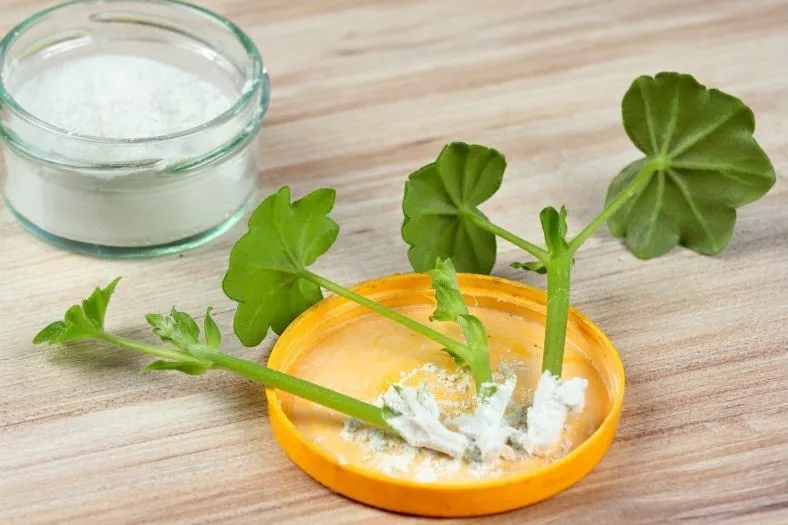
Powdered rooting hormone is an effective and popular method for promoting root growth. Follow these steps to apply rooting powder to your cuttings:
- Slightly moisten the cut end of your plant cutting.
- Dip the moistened end into the rooting hormone powder, ensuring complete coverage.
- Tap off any excess powder, leaving a thin layer of rooting hormone on the cut area.
- Place the cutting in your hydroponic system or a soilless growing medium, taking care not to rub off the hormone during insertion.
Whichever form of rooting hormone you choose, always ensure that you follow the manufacturer’s instructions for best results.
Related: Cloning with aeroponics also benefits from using a rooting hormone.
Can You Use Rooting Hormone In Water?
Typically, rooting hormones are beneficial for stimulating root growth in plant cuttings and accelerating their development either in soil or in an inert medium. When propagating plants hydroponically, you might wonder if it’s okay to use rooting hormone in water. The answer is yes, you can use rooting hormone for water propagation, but it’s essential to choose the appropriate product and use the right process.
If you’re attempting to grow roots by soaking plant cuttings in water, it is important to note that adding rooting hormones directly to the solution might overwhelm the tissues and cause them to wilt.
On the other hand, using rooting hormone on a stem cutting before placing it in the water can potentially increase the chances of success. Liquid or gel rooting hormones are best suited for water propagation. Apply these hormones to the stem cuttings immediately before placing them into the hydroponic system.

Here’s a quick guide on how to use rooting hormone on cuttings for your hydroponic plant propagation:
- Choose the right form of rooting hormone: Depending on your preference, rooting hormones are available as powders, gels, or liquids. Each type has its own set of guidelines for use.
- Prepare the plant cutting: Use a clean knife or shears to remove a fresh, healthy stem cutting from a parent plant. Make sure the cutting is long enough with several leaf nodes.
- Apply the rooting hormone: If using a liquid or gel form, simply dip the cut end of your cutting into the hormone for a few seconds. For powder form, you might need to dampen the cut end first before dipping it into the hormone. Most often, powder rooting hormones require the cutting to be dipped in distilled water and then placed into the powder. Always pour a small amount of the hormone into a separate container and never dip the cutting directly into the bottle to avoid contamination.
- Place the cutting in water: After applying the rooting hormone, insert the treated part of the cutting into the water, ensuring that it’s well submerged while leaving the leaves above the waterline.
Remember that the success of your hydroponic plant propagation also depends on factors such as the water temperature, cleanliness, and the presence of nutrients. Make sure to monitor the progress of your cuttings and adjust the conditions as needed.
How Long Does Rooting Hormone Take To Work?
Using a rooting hormone can significantly improve the success rate of your plant cuttings, but you might be wondering how long it takes for it to work. The answer depends on a few factors, such as the type of plant you’re propagating and the rooting hormone used.
In general, rooting hormones can take anywhere from two to eight weeks to work. However, this timeline can vary depending on the plant species and the conditions in your hydroponic system. For some difficult-to-propagate plants, it can take even longer for roots to develop, whereas other plants may root more easily and quickly. The important thing is to be patient and continue nurturing your cuttings during this process.
When using rooting hormone, it’s crucial to follow the right steps to achieve success:
- Select the right cutting: Choose a healthy plant cutting with at least one node, as this is where the roots will develop from.
- Prepare the cutting: Trim off excess leaves and make a clean cut at a 45-degree angle on the stem.
- Apply the rooting hormone: Dip the cut end of the stem into the rooting hormone, either in powder or liquid/gel form. Make sure not to leave it submerged for too long, as this can damage the plant.
- Plant the cutting: Place the cutting with the rooting hormone into your hydroponic system’s sterile, soilless growing medium.
- Maintain proper conditions: Keep the humidity levels high and provide the appropriate environment for the specific plant species you’re propagating.
By following these steps and maintaining the right conditions, you increase the chances of successful rooting using hormone products in a shorter period. Keep in mind that not all plants will take the same amount of time to root, even with the use of rooting hormones. So, keeping an eye on your cuttings and conducting regular check-ups are essential to ensure their healthy growth in your hydroponic system.
What To Use Instead Of Rooting Hormone
If you don’t have access to commercial rooting hormones or prefer a more natural approach, there are several alternatives you can use for hydroponic plant propagation. In this section, we will discuss a few of these options, including how to use aspirin as a rooting hormone, homemade rooting hormone recipes, and other natural rooting hormone sources.
Can You Use Aspirin as Rooting Hormone?
While aspirin does contain acetylsalicylic acid, which has been shown to have some rooting hormone-like properties, it is not commonly used as a rooting hormone. This is because aspirin can be toxic to plants if used in high concentrations, and it may not be as effective as other rooting hormone options that are specifically designed for this purpose.
There are several different types of rooting hormones available, including synthetic auxins such as indole-3-butyric acid (IBA) and naphthaleneacetic acid (NAA), as well as natural compounds such as willow extract and honey. These products are generally safer and more effective than aspirin when it comes to promoting root growth in plants.
Homemade Rooting Hormone Recipes
A popular homemade rooting hormone option is using cinnamon. Cinnamon has antibacterial and antifungal properties that can promote the healthy growth of stem cuttings. To use cinnamon as a rooting hormone:
- Take a cutting from a healthy plant.
- Dip the cut end of the cutting into ground cinnamon. Make sure the surface is completely covered.
- Place the cutting in your hydroponic system.
Another homemade rooting hormone recipe involves apple cider vinegar. It contains naphthaleneacetic acid, which can encourage rooting. To make an apple cider vinegar rooting hormone:
- Mix 3 teaspoons of apple cider vinegar with 1 gallon of water.
- Dip your cuttings into the solution before planting them in your hydroponic system.
Other Natural Rooting Hormones
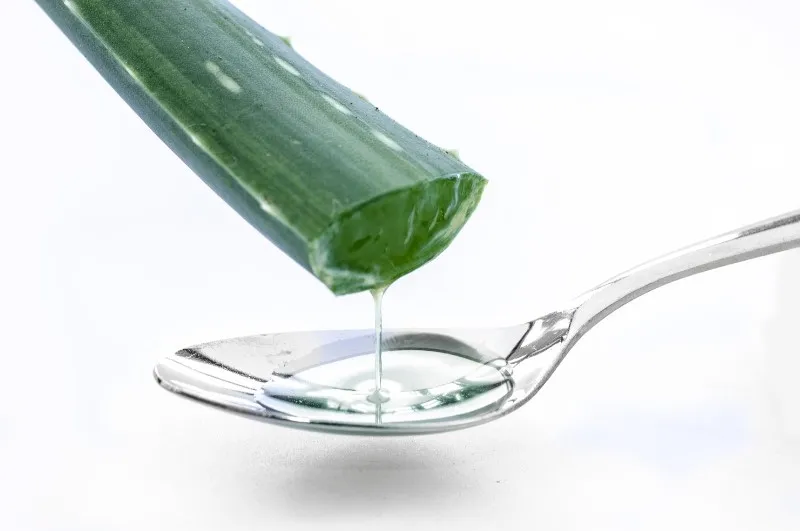
There are other natural substances that can be used as rooting hormones, such as honey, aloe vera, and willow extract. These alternatives have their own set of benefits and are easily accessible.
- Honey: It has natural antiseptic and antifungal properties that can help protect your cuttings from infections.
- Aloe Vera: Just like honey, it also has antibacterial and antifungal properties. Additionally, it contains vitamins, enzymes, and amino acids that can help promote root growth.
- Willow Extract: Willow trees contain a natural source of plant hormones called auxins, which help with root development. To create a willow extract rooting hormone, soak willow branches in water for a day or two, then use the water to soak your cuttings.
By using one of these natural or homemade rooting hormone alternatives, you can still efficiently propagate your hydroponic plants without relying on commercial rooting hormones.
Advanced Techniques

Using Root Cuttings
When using root cuttings for propagation, first, ensure your parent plant is healthy and vigorous. Take a healthy root segment, preferably with a growth tip, and apply rooting hormone to the cut. Place the treated root cutting in your chosen hydroponic planting medium, ensuring the growth tip is facing upwards. Maintaining optimal humidity and temperature is vital for successful root development.
Propagating Succulents
Succulents can also be propagated through leaf cuttings. Gently remove a healthy, mature leaf from the parent plant, ensuring the entire leaf is detached. Allow it to dry for a day, forming a callous on the cut edge. Apply rooting hormone to the calloused edge, and place it on a hydroponic planting medium, such as rockwool or coconut coir. High humidity and warm, indirect light help in the formation of roots and new growth.
Cloning
Cloning is a technique to create exact replicas of your favorite plants. Select a healthy and strong-growing stem tip segment from the parent plant, around three to eight inches long. Apply rooting hormone to the cut end of the stem cutting, and place it into a hydroponic planting medium. It’s essential to maintain a sterile environment, high humidity, and appropriate temperature to ensure the cutting forms roots and becomes a healthy clone.
FAQs
Final Thoughts
When it comes to gardening, especially hydroponic plant propagation, using rooting hormone can be a real game-changer. This chemical product is designed to stimulate and encourage root growth, helping you increase your chances of success when propagating plants from cuttings.
When working with hydroponics, it’s essential to apply rooting hormone to your cuttings immediately before placing them in the growing media.
Timing plays an important role in the success of plant propagation. The ideal time to take cuttings for propagation is usually in the fall when the plant’s growth rate slows down. This will increase the chances of your cutting taking root and thriving in its new hydroponic environment.
Here are some tips to keep in mind while using rooting hormones for propagating plants in hydroponic systems:
- Select healthy, disease-free parent plants for cuttings
- Choose non-flowering shoots or stems for higher success rates
- Make clean, angled cuts on the stems using sterilized tools
- Maintain proper humidity and temperature in your hydroponic system
- Be patient, as developing robust root systems can take time
By following these tips and using rooting hormones, you can make your plant propagation journey more enjoyable and fruitful. So go ahead and try this helpful technique to grow new plants that are identical to their parent plants, all within the confines of your hydroponic garden.

